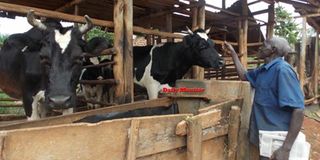Prime
Using animal manure and rainwater keeps their farm productive

Peter Ddaaki examines one of the family’s cows. Photo BY Michael J Ssali
Peter and Maria Severna Ddaaki, of Kitenga village near Masaka Town, are determined to enhance production of their small farm through efficient use of manure from animal dung and the rainwater they harvest.
The animal waste is also the source of biogas, which is used for lighting the cow shed and cooking in the family kitchen. “When the hydro-electricity goes off, we use the biogas,” says Peter Ddaaki, 80, a retired school teacher.
There are two cows, which produce about thirty litres of milk per day, and six pigs. “It is the waste from those animals that we use to keep the soil fertile,” he adds. “We use some of it for biogas and the rest as manure for both fodder and crop production. To us, fodder is as important as the crops. The animals have got to be fed well so we strive to produce both.”
When his reporter visited the homestead, he was preparing liquid manure for the Napier and Mulato Brachiaria grasses, which the animals feed on.
He explains: “I realised that the nitrogen in the bio-slurry is greatly reduced. So I put the slurry in this 500-litre tank. I mix it with cattle urine and immersed a perforated gunny bag with cow dung into the mixture. I turn the bag about a few times a day. After five days, the liquid manure will have gained enough nitrogen and is ready to apply on the fodder grass.”
The family traps water from the roof to an underground 30,000-litre tank. They have a treadle water pump, which is used to get water from the tank to wherever it is needed in the garden through a plastic tube.
They grow beans and vegetables throughout the year. They also grow maize in the same garden which has Napier grass. “Maize is also partly fodder because most of it is cut down after fruition and used to make silage,” Ddaaki adds.
The family earns income from not only milk and vegetables but from the sale of fodder to other farmers.
Benefits from research
The elderly couple does not use permanent hired labour. “We do most of the work ourselves. When she pumps the water, I am at the other end directing the water to the crops.”
Something else that the family is very passionate about is record keeping. They have a record of the litres of milk each of their cows produces every day. “We have realised that they produce more milk during drought periods when they feed on dry fodder, which we prepare right here.”
They credit Naro (National Agricultural Research Organisation) and Asareca (Association for Strengthening Agricultural Research in Eastern and Central Africa). Under a project, researchers such as Dr Jolly Kabirizi spent time at their farm and others in the neighbourhood. They watched the activities and made observations.
“Most of the technologies that we apply today on our farm were acquired from her training and the period we spent with her and the other researchers who visited us,” Ddaaki says.




